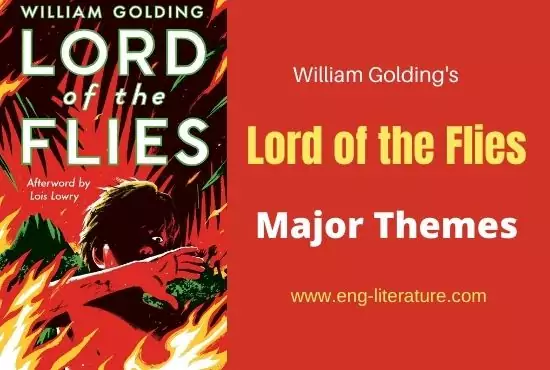Lord of the Flies Themes
Lord of the Flies, being an allegory abounds in layer of multiple themes. Here are some of these major themes:
Civilization Vs Savagery
The central theme of Lord of the Flies is the conflict on two competing impulses that exist within all hum beings: the instinct to live by rules, act peacefully, follow moral commands, against the instinct to gratify one’s desires, act violently to obtain supremacy over others. This conflict might be expressed as civilization vs. savagery, order vs. chaos, or good vs. evil. Throughout the novel, Golding associates the instinct of civilization with good and the instinct of savagery with evil, through different symbols.
The conflict between the two instincts is the driving force of the novel. Golding represents the conflict between civilization and savagery through Ralph, the protagonist, who represents order and leadership, and Jack, the antagonist, who represents savagery and the desire for power.
With the progresses in the story, Golding shows how different people feel the influences of the instincts of civilization and savagery to different degrees. Piggy, for instance, has no savage feelings, while Roger seems barely capable of comprehending the rules of civilization. Generally, however, Golding implies that the instinct of savagery is far more primal and fundamental to the human psyche than the instinct of civilization. Golding sees moral behaviour, in many cases, as something that civilization forces upon the individual rather than a natural expression of human individuality. When left to their own devices, Golding implies, people naturally revert to cruelty, savagery, and barbarism. This idea of innate human evil is central to Lord of the Flies. Among all the characters, only Simon seems to possess innate goodness in him.
Loss of Innocence
As the boys on the island progress from well-behave orderly children to cruel, bloodthirsty hunters who have no desire to return to civilization, they naturally lose the sense of innocence that they possessed at the beginning of the novel. The painted savages who have hunted, tortured, and killed animals and human beings. But Golding does not portray loss of innocence as something that is done to the children; rather, it results naturally from their increasing openness to the innate evil and savagery that has always existed within them. Golding implies that civilization can mitigate but never wipe out the innate evil that exists within all human beings. The forest glade in which Simon sits in symbolizes this loss of innocence. At first, it is a place of natural beauty and peace, but when Simon returns later in the novel, he discovers the bloody sow’s head impaled upon a stake in the middle of the clearing.
The Nature of Evil
“Lord of the Flies” Tries to explore the answers of the following questions:
Is evil innate within the human spirit, or is it an influence from an external source? What role do societal rules and institutions play in the existence of human evil? Does the capacity for evil vary from person to person, or does it depend on the circumstances each individual faces? A complex articulation of man’s potential for evil has been presented. Through detailed depictions of the boys’ different responses to their situation.
Here, it is important to note that Golding’s novel rejects supernatural or religious accounts of the origin of human evil.
Also read:
The Lord of the Flies communicates to Simon in the forest glade, the “beast” is an internal force, present in every individual, and is thus incapable of being truly defeated. That the most ethical characters on the island, Simon and Ralph, each come to recognize his own capacity for evil indicates the novel’s emphasis on evil’s universality among humans.
Even so, the novel is not entirely pessimistic about the human capacity for good. While evil impulses may lurk in every human psyche, the intensity of these impulses, and the ability to control them, appear to vary from individual to individual. Through the different characters, the novel presents continuum of evil, ranging from Jack and Roger, who are eager to engage in violence and cruelty, to Ralph and Simon who struggle to contain their brutal instincts. We may note that the characters who struggle most successfully against their evil instincts do so by appealing to ethical or social codes of behaviour.
Effect of Fear
Golding addresses the effects of fear on the individual and on a group. For individuals, fear distorts reality such as when Samneric’s terror at spotting the dead paratrooper magnifies their experience from merely seeing movement and hearing the parachute to being actively chased down the mountain as they flee. When the other boys hear Samneric’s tale, the group dynamic of fear comes into play. The boys do not band together to overcome this fearful situation through unity but allow their own worst impulses to surface and dominate, fragmenting into opposing groups and killing one of their own in a frenzy of fear and savagery.
The Consequences of War
Lord of the Flies is deeply concerned with the negative effects of war on individuals and for social relationships.
The arrival of the naval officer at the conclusion of the narrative underscores allegorical points. The implications of the officer’s presence are provocative: Golding suggests that even a war waged in the name of civilization can reduce humanity to a state of barbarism. The ultimate scene of the novel, in which the boys weep with grief for the loss of their innocence, implicates contemporary readers in the boys tragedy. The boys are representatives, however immature and untutored, of the wartime impulses of the period.

Hello, Viewers! Besides being the Founder and Owner of this website, I am a Government Officer. As a hardcore literary lover, I am pursuing my dream by writing notes and articles related to Literature. Drop me a line anytime, whether it’s about any queries or demands or just to share your well-being. I’d love to hear from you. Thanks for stopping by!
